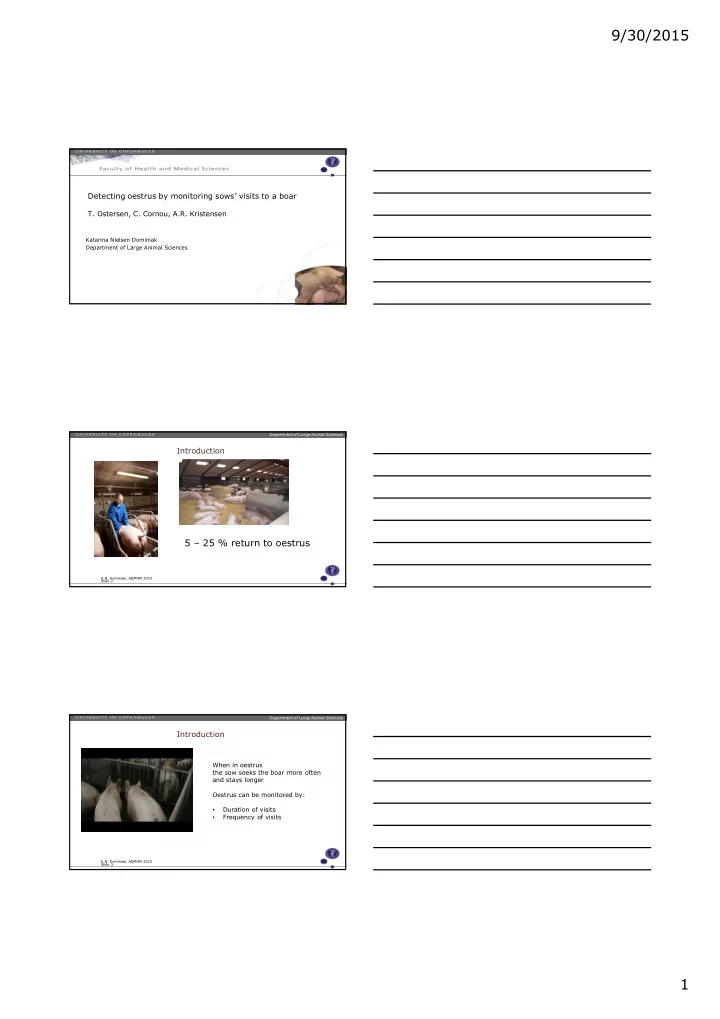

9/30/2015 Detecting oestrus by monitoring sows’ visits to a boar T. Ostersen, C. Cornou, A.R. Kristensen Katarina Nielsen Dominiak Department of Large Animal Sciences Department of Large Animal Sciences Introduction 5 – 25 % return to oestrus K.N. Dominiak, AQMHM 2015 Slide 2 Department of Large Animal Sciences Introduction When in oestrus the sow seeks the boar more often and stays longer Oestrus can be monitored by: Duration of visits • Frequency of visits • K.N. Dominiak, AQMHM 2015 Slide 3 1
9/30/2015 Department of Large Animal Sciences K.N. Dominiak, AQMHM 2015 Slide 4 Department of Large Animal Sciences Variation between sows – visiting patterns Individual variation in both level and variance Diurnal pattern Oestrus: Change in level of • duration Change in frequency • Increase in variance • Outliers does not necessarily indicate oestrus K.N. Dominiak, AQMHM 2015 Slide 5 Department of Large Animal Sciences Model characteristics Duration model: Response variable sec/hour • Adapt to individual level of • Multiproces dynamic linear model duration and variance MP-DLM Ignore outliers • Detect oestrus based on level shift • and increase in variance Frequency model: Response variable visits/6 hours • Dynamic generalized linear model Two diurnal periods (5 am - 5 pm) • DGLM Adapt to individual level • Handle Poisson distributed data • K.N. Dominiak, AQMHM 2015 Slide 6 2
9/30/2015 Department of Large Animal Sciences Duration model I More DLMs = Multiproces DLM Connected by First order Markov prior probabilities First six observations reset to ‘Normal’ > 6 hours between two observations resets to ‘Normal’ K.N. Dominiak, AQMHM 2015 Slide 7 Department of Large Animal Sciences Duration model II Normal Level shift Oestrus Outliers P(M OE ) = Indicator for oestrus K.N. Dominiak, AQMHM 2015 Slide 8 Department of Large Animal Sciences Frequency model I Remember from raw data: Two diurnal periods High frequency at day • Low frequency at night • 1-step forecast of the mean • Comparison with actual • observations K.N. Dominiak, AQMHM 2015 Slide 9 3
9/30/2015 Department of Large Animal Sciences Frequency model II Normal Change in frequency Oestrus Relative deviation from expected = oestrus indicator Threshold value 3.3 K.N. Dominiak, AQMHM 2015 Slide 10 Department of Large Animal Sciences Combining the two models P(M OE ) from the duration model Combined by Bayes Theorem Test results of frequency model SE of frequency model P(M OE ) Combined probability of oestrus given the result from the frequency model is positive or negative 1 - SE of frequency model K.N. Dominiak, AQMHM 2015 Slide 11 Department of Large Animal Sciences Results I SP: Ability to identify non-oestrus correctly SE: Ability to identify oestrus correctly LR + : Reliability of positive test result Error rate: Proportion of alarms being false K.N. Dominiak, AQMHM 2015 Slide 12 4
9/30/2015 Department of Large Animal Sciences Discussion Extremely high SP – important when rare condition High error rates – too many false alarms Duration output communicated as a probability of oestrus - how do you think a farmer would embrace such an output? K.N. Dominiak, AQMHM 2015 Slide 13 Department of Large Animal Sciences Thank you K.N. Dominiak, AQMHM 2015 Slide 14 5
Recommend
More recommend